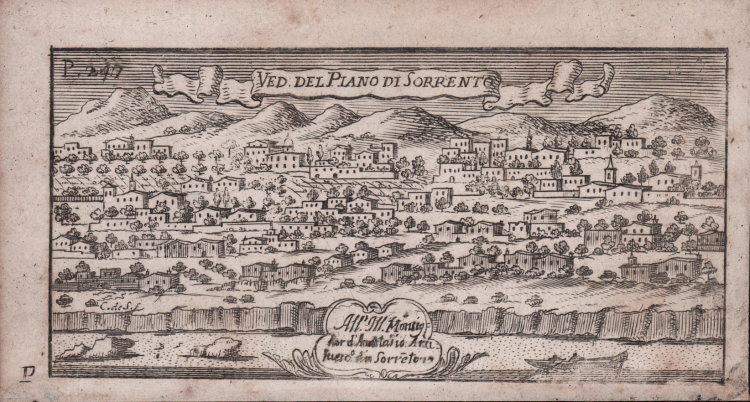



| Reference: | CO-786 |
| Author | Antonio BULIFON |
| Year: | 1697 ca. |
| Zone: | Sorrento |
| Printed: | Naples |
| Measures: | 125 x 65 mm |


| Reference: | CO-786 |
| Author | Antonio BULIFON |
| Year: | 1697 ca. |
| Zone: | Sorrento |
| Printed: | Naples |
| Measures: | 125 x 65 mm |
Piccola veduta tratta dalla celebre guida di Pompeo Sarnelli, con le tavole calcografiche di Antonio Bulifon, stampata con il titolo di Guida de' forestieri, curiosi di vedere, e d'intendere le cose più notabili della regal città di Napoli, e del suo amenissimo distretto. Ritrovata colla lettura de' buoni scrittori, e colla propria diligenza dell'abate Pompeo Sarnelli, hoggi vescovo di Biseglia. In questa nuova edizione dall'autore molto amplata, e da Antonio Bulifon di vaghe figure abbellita [In Napoli: presso Giuseppe Roselli, 1697.
Acquaforte, in buono stato di conservazione.
Antonio BULIFON (Chaponay 1649 - Spagna dopo il 1707)
|
Antonio Bulifon born in Chaponay. He came to Naples as a young man in 1670, and began his career in the print trade by working as a clerk
in a bookstore. Three years later, when he married a Neapolitan woman,
Maddelena Criscuolo, he had already opened his own shop on what was then
the booksellers’ row of Naples, Via San Biagio dei Librai. He never owned his
own presses, but instead rented those of other Neapolitan printers. For his
printer’s device he chose a Siren, perhaps a symbol for his adopted city, and
the motto “non sempre nuoce” (“she does not always harm”). Bulifon’s operation produced a wide variety of genres: history, lyric poet-
ry, scientific and legal treatises, translations in both French and Italian, and
collections of letters. While today he is often remembered for his series dedi-
cated to sixteenth-century women poets, such as Vittoria Colonna (Stone 92),
Bulifon specialized in publishing texts related to Naples and Neapolitan cul-
ture. These included histories of the city and its noble families; a catalog of
Neapolitan writers; guidebooks in Italian and French describing the archeo-
logical, artistic, and natural treasures of the region; accounts of the eruptions
of Mount Vesuvius; and a gazette dedicated to recording local events of note. His interest in Neapolitan culture also encompassed dialect literature. Indeed,
one of the first works he printed was Basile’s Lo cunto de li cunti (1674). Edited
by Pompeo Sarnelli, a cleric from Puglia who used the pseudonym Masillo
Reppone when writing or editing dialect texts, Bulifon’s edition of Basile’s tales
was the first to bear the alternative title Il Pentamerone. Bulifon continued writing, editing, and directing his press for thirty years.
Sometime at the beginning of the eighteenth century, he turned the business
over to his son Niccolò (De Caro 61). Niccolò Bulifon had been managing the
family press for four years when in July 1707 the Austrians invaded Naples,
driving out the Spanish-French factions to which his family belonged. By this
time, his father, Antonio, had fled to Spain, where he sought the protection of Philip V, his former patron.6 Shortly after the Austrian invasion, an angry
mob—perhaps incited by one of the Bulifons’ competitors—attacked and
destroyed the bookshop. Antonio Bulifon died in 1707 in Spain.
|
Antonio BULIFON (Chaponay 1649 - Spagna dopo il 1707)
|
Antonio Bulifon born in Chaponay. He came to Naples as a young man in 1670, and began his career in the print trade by working as a clerk
in a bookstore. Three years later, when he married a Neapolitan woman,
Maddelena Criscuolo, he had already opened his own shop on what was then
the booksellers’ row of Naples, Via San Biagio dei Librai. He never owned his
own presses, but instead rented those of other Neapolitan printers. For his
printer’s device he chose a Siren, perhaps a symbol for his adopted city, and
the motto “non sempre nuoce” (“she does not always harm”). Bulifon’s operation produced a wide variety of genres: history, lyric poet-
ry, scientific and legal treatises, translations in both French and Italian, and
collections of letters. While today he is often remembered for his series dedi-
cated to sixteenth-century women poets, such as Vittoria Colonna (Stone 92),
Bulifon specialized in publishing texts related to Naples and Neapolitan cul-
ture. These included histories of the city and its noble families; a catalog of
Neapolitan writers; guidebooks in Italian and French describing the archeo-
logical, artistic, and natural treasures of the region; accounts of the eruptions
of Mount Vesuvius; and a gazette dedicated to recording local events of note. His interest in Neapolitan culture also encompassed dialect literature. Indeed,
one of the first works he printed was Basile’s Lo cunto de li cunti (1674). Edited
by Pompeo Sarnelli, a cleric from Puglia who used the pseudonym Masillo
Reppone when writing or editing dialect texts, Bulifon’s edition of Basile’s tales
was the first to bear the alternative title Il Pentamerone. Bulifon continued writing, editing, and directing his press for thirty years.
Sometime at the beginning of the eighteenth century, he turned the business
over to his son Niccolò (De Caro 61). Niccolò Bulifon had been managing the
family press for four years when in July 1707 the Austrians invaded Naples,
driving out the Spanish-French factions to which his family belonged. By this
time, his father, Antonio, had fled to Spain, where he sought the protection of Philip V, his former patron.6 Shortly after the Austrian invasion, an angry
mob—perhaps incited by one of the Bulifons’ competitors—attacked and
destroyed the bookshop. Antonio Bulifon died in 1707 in Spain.
|